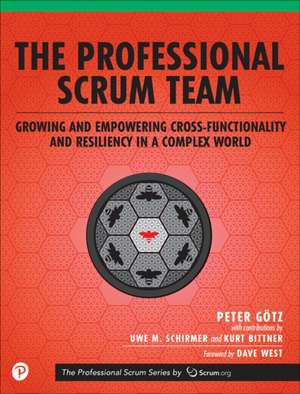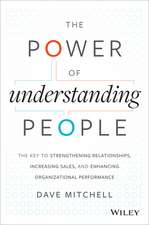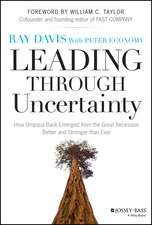The Professional Scrum Team: The Professional Scrum Series
Autor Peter Götz, Uwe Schirmer, Kurt Bittneren Limba Engleză Paperback – 15 dec 2020
- As you share the teams experience--facing and overcoming realistic challenges--you'll discover better ways to work together, enhance your practices, leverage tools, continuously improve, and deliver functionality in ever-shorter cycles.
- Understand how Scrum Teams work, collaborate, and promote transparency
- Explore common problems that lead less experienced Scrum Teams to give up
- Find your Scrum Teams best approach to solving complex adaptive problems
- Integrate DevOps practices with Scrum to improve effectiveness
- Productively and professionally resolve conflicts that arise from close collaboration
- Help your organisation learn how to improve its results by better supporting its Scrum Teams
- This guide is for anyone who works with Scrum Teams or wants to become more effective as a Scrum Team member or leader.
Preț: 214.12 lei
Nou
Puncte Express: 321
Preț estimativ în valută:
40.97€ • 42.97$ • 34.11£
40.97€ • 42.97$ • 34.11£
Carte disponibilă
Livrare economică 11-25 martie
Livrare express 25 februarie-01 martie pentru 25.44 lei
Preluare comenzi: 021 569.72.76
Specificații
ISBN-13: 9780134862156
ISBN-10: 0134862155
Pagini: 224
Dimensiuni: 175 x 229 x 13 mm
Greutate: 0.35 kg
Editura: Pearson Education
Seria The Professional Scrum Series
ISBN-10: 0134862155
Pagini: 224
Dimensiuni: 175 x 229 x 13 mm
Greutate: 0.35 kg
Editura: Pearson Education
Seria The Professional Scrum Series
Notă biografică
Peter G�tz is a consultant, trainer, and coach. He began his career as a Java software developer in 2001 and moved into consulting in 2006. He is also a Professional Scrum Trainer for Scrum.org and has been assisting teams as a Scrum Coach since 2008. As one of the stewards for the Professional Scrum Developer training, he maintains and develops the course material and learning path. He is passionate about software architecture and DevOps and likes to discuss ways to improve the work Scrum Teams do by using modern architectural styles and engineering practices to improve flow. Peter lives near Munich with his wife and their three children, and only has hobbies that start with b: brewing beer, baking bread, and beekeeping. He tried sailing once but only could enjoy it when he realized he was sitting in a boat. Find him on Twitter as @petersgoetz or visit his website, pgoetz.de/en. Uwe M. Schirmer is a certified Scrum expert, software architect, project manager, and requirements engineer. He has been involved with computers since the 1980s. After two professional educations, he studied computer science at the University of Applied Science in Fulda, Germany. Since 1996, he has worked as a trainer, and since 2000, he has worked as consultant for different customers and projects. Today, he works as an Agile Coach and Software Architect at Accenture | SolutionsIQ, where he helps to modernize organizations without losing sight of the product, quality, and architecture of their applications and infrastructure. His main interests are agile software development, emergent design and architecture, documentation of software architectures, DevOps, developing teams, and the evolution of organizational cultures. He lives with his wife, three children, and four chickens near Frankfurt in Germany. Kurt Bittner has more than 35 years of experience helping teams to deliver software in short feedback-driven cycles, as a developer, as a product manager, and product owner; as an industry analyst; and as an organizational change agent. He is the author of three other books on software engineering, many blogs and articles, and is a frequent speaker at conferences.
Cuprins
Foreword xi
Introduction xv
Acknowledgments xxi
About the Authors xxv
Chapter 1: Being an Effective Scrum Team 1
Collaboration Between Product Owner and Development Team 3
Creating Transparency as a Scrum Team 10
Summary 25
Chapter 2: Common Problems 27
Missing Basics 29
Common Misunderstandings about Scrum 38
Avoidable Errors 46
Summary 54
Chapter 3: Scrum Is Not Enough 55
Strategy: Take Care of the Big Picture 56
Tactics: Work from Idea to Result 62
How to Improve Cross-functionality 71
Coping with Constant Change 77
Summary 83
Chapter 4: Releasable Is Less Than Released 85
What Is DevOps? 86
How to Combine Scrum and DevOps 91
Summary 99
Chapter 5: Resolving Conflict 101
Conflict That Can Be Solved by People Involved 102
Conflict That Needs Outside Intervention 107
Toxic Conflict That Needs Stronger Intervention 114
Summary 119
Chapter 6: Measure Success 121
Working Toward Goals 122
Improving Team Results 132
Summary 141
Chapter 7: Scrum and Management 143
The Role of Management in Scrum 144
How to Enable Self-organization 148
Summary 152
Chapter 8: The Agile Organization 153
Organizational Structures Can Either Help or Hinder Scrum 154
Complex Organizations Need Radical Simplicity 159
Summary 164
Chapter 9: Continuous Improvement Never Stops 167
How to Keep Improvement Continuous 168
Retrospectives as the Driver for Improvement 173
Will Scrum Ever Be Complete? 176
Summary 182
Bibliography 183
Index 185
Introduction xv
Acknowledgments xxi
About the Authors xxv
Chapter 1: Being an Effective Scrum Team 1
Collaboration Between Product Owner and Development Team 3
Creating Transparency as a Scrum Team 10
Summary 25
Chapter 2: Common Problems 27
Missing Basics 29
Common Misunderstandings about Scrum 38
Avoidable Errors 46
Summary 54
Chapter 3: Scrum Is Not Enough 55
Strategy: Take Care of the Big Picture 56
Tactics: Work from Idea to Result 62
How to Improve Cross-functionality 71
Coping with Constant Change 77
Summary 83
Chapter 4: Releasable Is Less Than Released 85
What Is DevOps? 86
How to Combine Scrum and DevOps 91
Summary 99
Chapter 5: Resolving Conflict 101
Conflict That Can Be Solved by People Involved 102
Conflict That Needs Outside Intervention 107
Toxic Conflict That Needs Stronger Intervention 114
Summary 119
Chapter 6: Measure Success 121
Working Toward Goals 122
Improving Team Results 132
Summary 141
Chapter 7: Scrum and Management 143
The Role of Management in Scrum 144
How to Enable Self-organization 148
Summary 152
Chapter 8: The Agile Organization 153
Organizational Structures Can Either Help or Hinder Scrum 154
Complex Organizations Need Radical Simplicity 159
Summary 164
Chapter 9: Continuous Improvement Never Stops 167
How to Keep Improvement Continuous 168
Retrospectives as the Driver for Improvement 173
Will Scrum Ever Be Complete? 176
Summary 182
Bibliography 183
Index 185


























